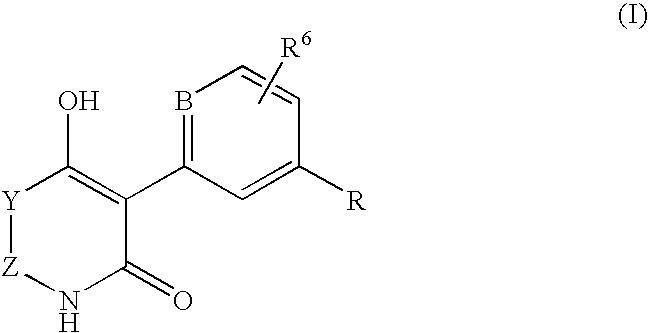Use of thienopyridone derivatives as ampk activators and pharmaceutical compositions containing them
a technology of ampk activator and thienopyridone, which is applied in the field of thienopyridone derivatives, can solve problems such as the decrease of body weight, achieve the effects of reducing hepatic glucose output, improving overall glucose homeostasis, and reducing expression of gluconeogenic enzymes
- Summary
- Abstract
- Description
- Claims
- Application Information
AI Technical Summary
Benefits of technology
Problems solved by technology
Method used
Image
Examples
example 1
[0151]A solution of 0.6 g of methyl 5-chloro-4-methyl-2-(phenylaceta-mido)thiophene-3-carboxylate (m.p.: 105-1070; obtainable by chlorinating the corresponding chlorine-free compound with N-chlorosuccinimide) in 20 mL of THF is cooled down to −70°. 8.16 mL of a 0.5 molar solution of KN(Si(CH3)3)2 in toluene are then added dropwise. The reaction solution is slowly brought to room temperature and then evaporated. The residue is taken up in water, and this solution is extracted several times with diethyl ether. The aqueous phase is then acidified with 2 N HCl, and the precipitate is filtered off, washed with water and, after having been digested with diethyl ether, filtered off once again and dried. 2-Chloro-3-methyl-4-hydroxy-5-phenyl-6,7-dihydro-thieno[2,3-b]pyridin-6-one is obtained.
[0152]Rf (CH2Cl2 / MeOH 10:1): 0.43.
examples 2 to 8
[0153]The following 2-R2-3-R1-4-hydroxy-5-phenyl-6,7-dihydrothieno[2,3-b]pyridin-6-ones:
Ex.R1R2Rf(CH2Cl2 / MeOH 10:1)2MeH0.433HMe0.364MeMe0.495HEt0.446HH0.317MeBr0.388HBr0.34
[0154]are obtained, in analogy with Example 1, from the following methyl or ethyl 2-phenylacetamido-4-R1-5-R2-thiophene-3-carboxylates, respectively:
Precursorof Ex.R1R2AM.p.2MeHMe105.5-106.5°3HMeMe110.5-111.5°4MeMeEt84-86°5HEtMe105-106°6HHMe90-92°7MeBrMe 105-106.5°8HBrMe—
[0155]In the above table, A stands for the methyl or ethyl ester group.
examples 9 to 72
[0156]The following 2-chloro-3-methyl-4-hydroxy-5-(3-R-phenyl)-6,7-dihydro-thieno[2,3-b]pyridin-6-ones:
Ex.R9phenoxy, Rf 0.4410o-methylphenxoy11m-methylphenoxy12p-methylphenoxy13o-methoxyphenoxy14m-methoxyphenoxy15p-methoxyphenoxy16o-fluorophenoxy17m-fluorophenoxy18p-fluorophenoxy19o-chlorophenoxy20m-chlorophenoxy21p-chlorophenoxy22o-trifluoromethylphenoxy23m-trifluoromethylphenoxy24p-trifluoromethylphenoxy25benzyl26o-methylbenzyl27m-methylbenzyl28p-methylbenzyl29o-methoxybenzyl30m-methoxybenzyl31p-methoxybenzyl32o-fluorobenzyl33m-fluorobenzyl34p-fluorobenzyl35o-chlorobenzyl36m-chlorobenzyl37p-chlorobenzyl38o-trifluoromethylbenzyl39m-trifluoromethylbenzyl40p-trifluoromethylbenzyl41benzoyl42o-methylbenzoyl43m-methylbenzoyl44p-methylbenzoyl45o-methoxybenzoyl46m-methoxybenzoyl47p-methoxybenzoyl48o-fluorobenzoyl49m-fluorobenzoyl50p-fluorobenzoyl51o-trifluoromethylbenzoyl52m-trifluoromethylbenzoyl53p-trifluoromethylbenzoyl54o-chlorobenzoyl55m-chlorobenzoyl56p-chlorobenzoyl57anilino58o-met...
PUM
| Property | Measurement | Unit |
|---|---|---|
| Mass | aaaaa | aaaaa |
| Mass | aaaaa | aaaaa |
| Mass | aaaaa | aaaaa |
Abstract
Description
Claims
Application Information
 Login to View More
Login to View More - R&D
- Intellectual Property
- Life Sciences
- Materials
- Tech Scout
- Unparalleled Data Quality
- Higher Quality Content
- 60% Fewer Hallucinations
Browse by: Latest US Patents, China's latest patents, Technical Efficacy Thesaurus, Application Domain, Technology Topic, Popular Technical Reports.
© 2025 PatSnap. All rights reserved.Legal|Privacy policy|Modern Slavery Act Transparency Statement|Sitemap|About US| Contact US: help@patsnap.com



